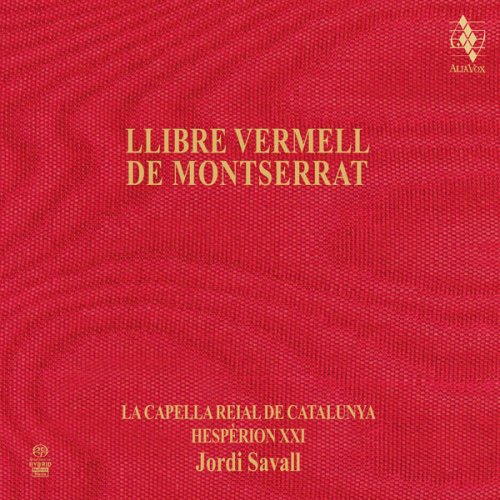Jordi Savall - Llibre Vermell de Montserrat (2016) [Hi-Res]

Artist: Jordi Savall
Title: Llibre Vermell de Montserrat
Year Of Release: 2016
Label: Alia Vox
Genre: Classical, Medieval Era, Sacred
Quality: flac lossless / flac 24bits - 88.2kHz +booklet
Total Time: 01:11:44
Total Size: 389 mb / 1.2 gb
WebSite: Album Preview
TracklistTitle: Llibre Vermell de Montserrat
Year Of Release: 2016
Label: Alia Vox
Genre: Classical, Medieval Era, Sacred
Quality: flac lossless / flac 24bits - 88.2kHz +booklet
Total Time: 01:11:44
Total Size: 389 mb / 1.2 gb
WebSite: Album Preview
---------
01. O Virgo splendens (monodic)
02. O Virgo splendens (canon a 2 i a 3)
03. Improvisació arpa
04. Stella splendens
05. Improvisació duduk
06. Laudemus Virginem
07. Improvisació santur
08. Los set gotxs
09. Improvisació duduk & flauta
10. Splendens ceptigera
11. Improvisació cistre
12. Polorum regina
13. Improvisació rebab i arpa
14. Cuncti simus concanentes
15. Improvisació llaüt
16. Mariam matrem Virginem
17. Improvisació viella
18. Imperayritz de la ciutat joyosa
19. Improvisació cornamusa & xeremia
20. Ad mortem festinamus
21. O Virgo splendens (canon a 3 & monodic)
22. Quant ai lo mont consirat (Bonus Track)
Jordi Savall is among the leading instrumentalists and conductors of the European early music scene, specializing in Renaissance and medieval music. He began studying music when he was six, learning cello and pursuing that instrument at the Barcelona Conservatory. He took an interest in early music, and began learning the viola da gamba. That instrument possesses approximately the same range and similar playing technique as the cello, but instead of being a member of the violin family is part of the related, older family of stringed instruments, the viol family, visually most easily distinguished from their cousins by their sloping shoulder lines. As its name denotes, the instrument, smaller than a cello, is ordinarily held in the lap. Savall also gained proficiency in the various members of the viola family. He studied that instrument and early music research and practice with Wieland Kuijken in Brussels and August Wenziger at the Schola Cantorum Basiliensis in Basel, obtaining a diploma as soloist and professor in 1970. In 1973 he succeeded to Wenziger's position. In 1968 he had married the soprano Montserrat Figueras, who shared his interest in early music. With her and other musicians interested in early Spanish music, he founded in 1974 the ensemble Hespèrion XX. The ensemble took its name from an ancient name for the Western European region from Italy to Iberia; Hespèrion was also a name for Venus as the Evening Star (in which aspect it appears only in the western skies). He and Hespèrion XX quickly became well known in early music circles. They created a unique sound through the use of viols and other medieval instruments such as the psaltery, wooden flutes, Moroccan drums, and the Afghan rebec (a double-reed ancestor of the oboe). All these instrument are known to have been used by medieval musicians, particularly in the Mediterranean region. Savall became internationally known through his playing on the soundtrack of Alain Corneau's film Tous les Matins du Monde (All the Mornings of the World), concerning the French viol players of the Baroque era. Savall has extended his area of musical interest into the Baroque, leading performances of Orfeo by Monteverdi and Il Burbero de Buion Cuore by Martin y Soler, and in the late 1990s conducted Beethoven's Eroica symphony with Le Concert des Nations (a group he founded in 1989 for Baroque music), winning praise for his well-researched and groundbreaking interpretation. He also founded Le Capella Reial de Catalunya in 1987, an ensemble of instrumentalists and vocal soloist. He has recorded around a hundred releases, mostly on the Astrée Auvidis label, receiving the Diapason d'Or award.






![Tomasz Stanko, Polskie Radio - Jazz Rock Company: Live at Akwarium (Polish Radio Sessions vol. 6/6) (2025) [Hi-Res] Tomasz Stanko, Polskie Radio - Jazz Rock Company: Live at Akwarium (Polish Radio Sessions vol. 6/6) (2025) [Hi-Res]](https://www.dibpic.com/uploads/posts/2025-12/1765796554_cover.jpg)
![Cornelius Claudio Kreusch - Scoop (2025) [Hi-Res] Cornelius Claudio Kreusch - Scoop (2025) [Hi-Res]](https://www.dibpic.com/uploads/posts/2025-12/1765893706_folder.jpg)
